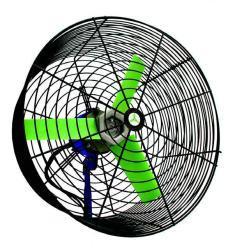Traditionally HAF systems destratify air layers and keep temperatures at a consistent level throughout the controlled environment. The fans used in most HAF systems were designed by HVAC engineers with their only goal being to mix air levels. The designers gave little thought to ensuring airflow reached the plant canopy. The only goal was to create uniform temperatures inside greenhouses. Energy hungry brushed motors were paired with basic stamped blades and placed inside a basket to avoid employee injury. These fans worked. Growers were able to keep plants alive throughout all climates during the extreme weather cycles.
Crop Level Fans also effectively mix air levels creating uniform temperatures throughout controlled environments. Where they differ is in the size of their air cones and their ability to infinitely adjust to achieve desired airflow levels inside the canopy of crops.
The concept of Crop Level Fans was born in Northern California in the early 2000's by Lucien Eddisford, founder of Snap-Fan LLC. He was aware of past and ongoing airflow research in controlled environment agriculture (CEA). The benefits of airflow inside of crops has been, and continues to be, researched by agronomists and scientists all over the world.
One of the more notable researchers on this subject is Kazutoshi Yabuki, a Japanese Agronomist at Osaka Prefecture University. He conducted numerous studies proving the direct correlation between airflow speed and rate of photosynthesis effecting overall plant growth. He discovered that plants were able to photosynthesize at higher rates when exposed to a light breeze. Higher rates of photosynthesis lead to healthier plants, faster plant growth, and higher yields.
Other notable researchers include Stanislaus J. Schymanski and Dani Or, with the Department of Environmental Systems Sciences in Zurich, Switzerland. They conducted research proving that airflow at the crop level increases leaf water use efficiency. Essentially, leaves exposed to airflow were able to maintain temperature with less and less water as airflow increased. Leaves that use water more efficiently can photosynthesize at higher rates, again leading to faster growth rates and higher yields.
Further research of particular is published in Frontiers in Plant Science. The document is titled, "The 4-Dimensional Plant: Effects of Wind-Induced Canopy Movement on Light Fluctuations and Photosynthesis". Many different current and past researchers' work came together in this piece, dating all the way back to Darwin in the 1800's. The body of the work studies Mechanical Canopy Excitation (leaf flutter created by airflow). In summary, the research points to better light absorption in the sub-canopy created by leaf flutter from airflow, resulting in higher photosynthesis rates and faster plant growth.
Lucien was very involved in the green house airflow industry prior to his new development. He was aware of the limitations of current HAF fans available on the market as he was currently manufacturing them. So, armed with the knowledge of researchers all over the world, he sought out to engineer a new line of fans that could be used to provide the crop level flows that all the research indicated would be optimal. In concept, the idea seemed simple. He needed to create an infinitely variable speed fan, with a wide cone of air, that would allow growers to tune airflow to optimal levels in the crop canopy. It was easier said than done but, after many years in development, and with the help from researchers at top universities and leading agronomists around the world, Lucien succeeded and the EC20 Max line of fans was born. Lucien accomplished all of his goals with the design while taking advantage of further technological advances in motor technology. His design proved to be the most energy efficient, and most powerful 20" fan ever created for agriculture applications.
Snap-Fan's crop level fans are currently running in a broad range of facilities around the world. End users are reporting significantly improved airflow throughout a broad range of crops. Finally, growers have a tool that allows them to take advantage of the many years of research.
